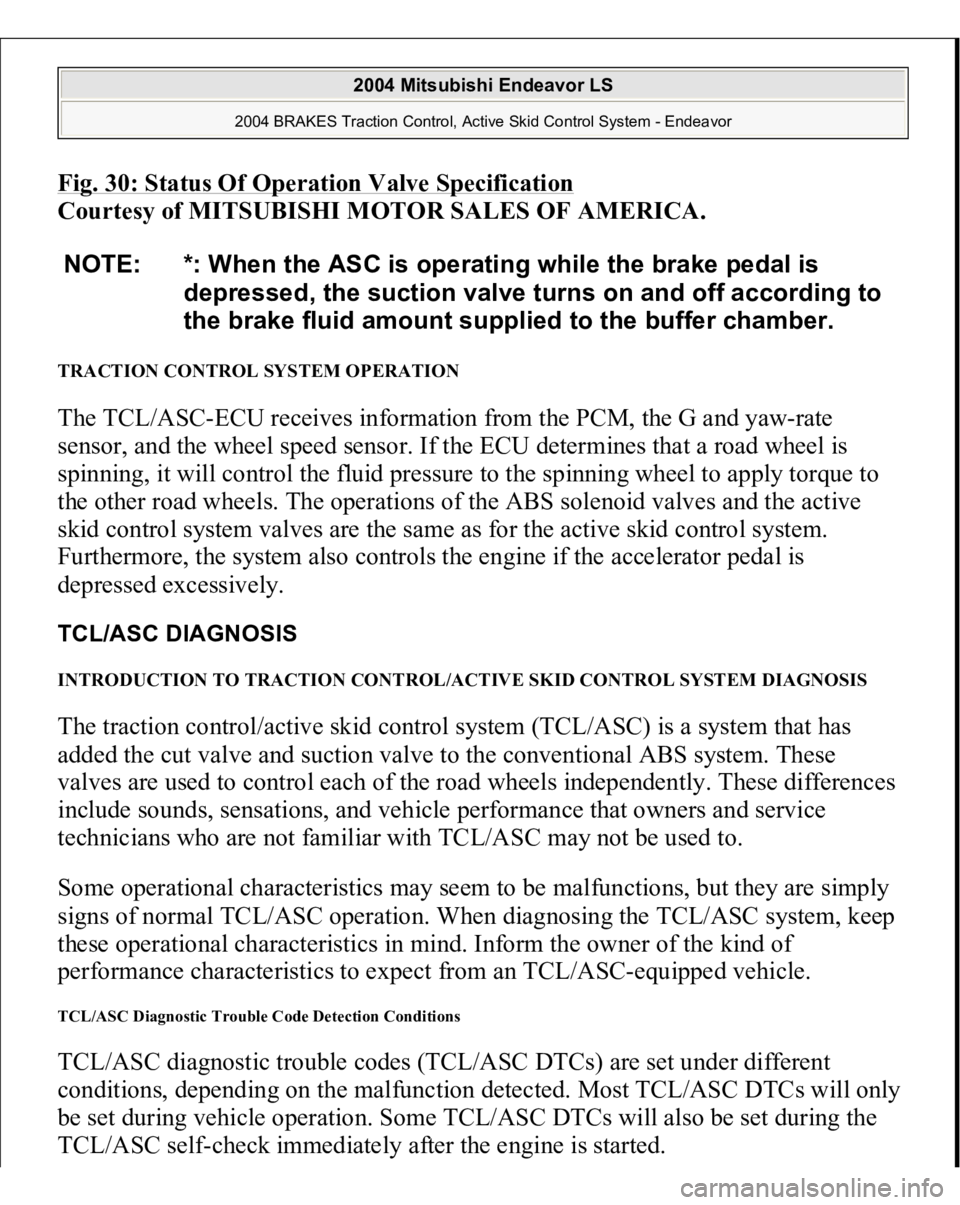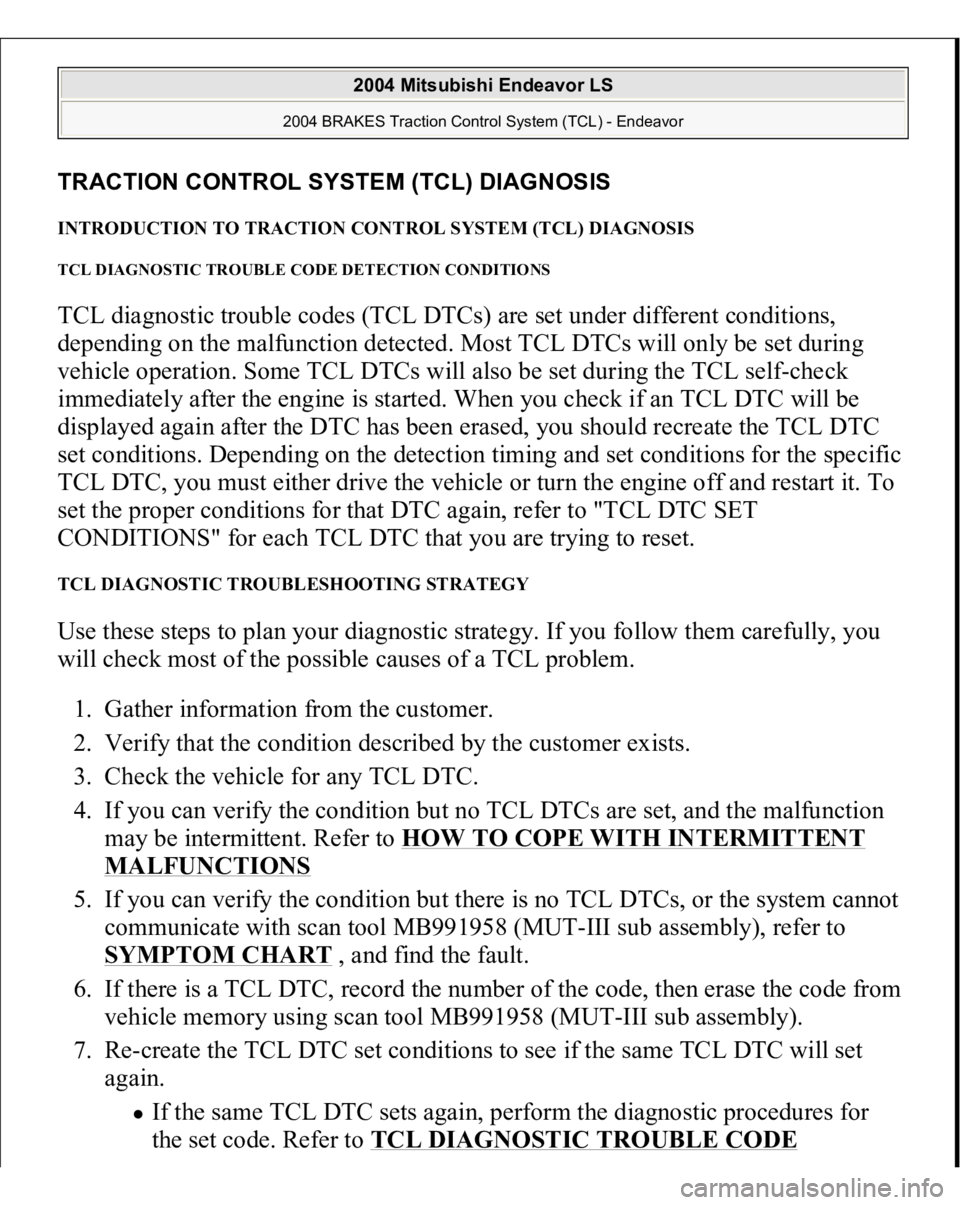Page 3038 of 3870
Fig. 2: Rear Suspension Construction Diagram (AWD)
Courtesy of MITSUBISHI MOTOR SALES OF AMERICA.
REAR SUSPENSION DIAGNOSIS INTRODUCTION TO REAR SUSPENSION DIAGNOSIS If the rear suspension is faulty, the vehicle will not run straightforward or noise will
occur. Incorrect wheel alignment, malfunction of shock absorber, stabilizer bar, coil
spring, control arms or worn or out-of-balance will cause these problems. REAR SUSPENSION DIAGNOSTIC TROUBLESHOOTING STRATEGY Use these steps to plan your diagnostic strategy. If you follow them carefully, you
will be sure that you have exhausted most of the possible ways to find a rear
suspension fault.
1. Gather information from the customer.
2. Verify that the condition described by the customer exists.
3. Find the malfunction by following the Symptom Chart.
4. Verif
y malfunction is eliminated.
2004 Mitsubishi Endeavor LS 2004 SUSPENSION Rear - Endeavor
Page 3134 of 3870

Fig. 30: Status Of Operation Valve Specificatio
n
Courtesy of MITSUBISHI MOTOR SALES OF AMERICA.
TRACTION CONTROL SYSTEM OPERATION The TCL/ASC-ECU receives information from the PCM, the G and yaw-rate
sensor, and the wheel speed sensor. If the ECU determines that a road wheel is
spinning, it will control the fluid pressure to the spinning wheel to apply torque to
the other road wheels. The operations of the ABS solenoid valves and the active
skid control system valves are the same as for the active skid control system.
Furthermore, the system also controls the engine if the accelerator pedal is
depressed excessively. TCL/ASC DIAGNOSIS INTRODUCTION TO TRACTION CONTROL/ACTIVE SKID CONTROL SYSTEM DIAGNOSIS The traction control/active skid control system (TCL/ASC) is a system that has
added the cut valve and suction valve to the conventional ABS system. These
valves are used to control each of the road wheels independently. These differences
include sounds, sensations, and vehicle performance that owners and service
technicians who are not familiar with TCL/ASC may not be used to.
Some operational characteristics may seem to be malfunctions, but they are simply
signs of normal TCL/ASC operation. When diagnosing the TCL/ASC system, keep
these operational characteristics in mind. Inform the owner of the kind of
performance characteristics to expect from an TCL/ASC-equipped vehicle. TCL/ASC Diagnostic Trouble Code Detection Conditions TCL/ASC diagnostic trouble codes (TCL/ASC DTCs) are set under different
conditions, depending on the malfunction detected. Most TCL/ASC DTCs will only
be set during vehicle operation. Some TCL/ASC DTCs will also be set during the
TCL/ASC self-check immediatel
y after the en
gine is started.
NOTE: *: When the ASC is operating while the brake pedal is
depressed, the suction valve turns on and off according to
the brake fluid amount supplied to the buffer chamber.
2004 Mitsubishi Endeavor LS
2004 BRAKES Traction Control, Active Skid Control System - Endeavor
Page 3581 of 3870

TRACTION CONTROL SYSTEM (TCL) DIAGNOSIS INTRODUCTION TO TRACTION CONTROL SYSTEM (TCL) DIAGNOSIS TCL DIAGNOSTIC TROUBLE CODE DETECTION CONDITIONS TCL diagnostic trouble codes (TCL DTCs) are set under different conditions,
depending on the malfunction detected. Most TCL DTCs will only be set during
vehicle operation. Some TCL DTCs will also be set during the TCL self-check
immediately after the engine is started. When you check if an TCL DTC will be
displayed again after the DTC has been erased, you should recreate the TCL DTC
set conditions. Depending on the detection timing and set conditions for the specific
TCL DTC, you must either drive the vehicle or turn the engine off and restart it. To
set the proper conditions for that DTC again, refer to "TCL DTC SET
CONDITIONS" for each TCL DTC that you are trying to reset. TCL DIAGNOSTIC TROUBLESHOOTING STRATEGY Use these steps to plan your diagnostic strategy. If you follow them carefully, you
will check most of the possible causes of a TCL problem.
1. Gather information from the customer.
2. Verify that the condition described by the customer exists.
3. Check the vehicle for any TCL DTC.
4. If you can verify the condition but no TCL DTCs are set, and the malfunction
may be intermittent. Refer to HOW TO COPE WITH INTERMITTENT
MALFUNCTIONS
5. If you can verify the condition but there is no TCL DTCs, or the system cannot
communicate with scan tool MB991958 (MUT-III sub assembly), refer to
SYMPTOM CHART , and find the fault.
6. If there is a TCL DTC, record the number of the code, then erase the code from
vehicle memory using scan tool MB991958 (MUT-III sub assembly).
7. Re-create the TCL DTC set conditions to see if the same TCL DTC will set
again.
If the same TCL DTC sets again, perform the diagnostic procedures for
the set code. Refer to TCL DIAGNOSTIC TROUBLE CODE
2004 Mitsubishi Endeavor LS
2004 BRAKES Traction Control System (TCL) - Endeavor
Page:
< prev 1-8 9-16 17-24